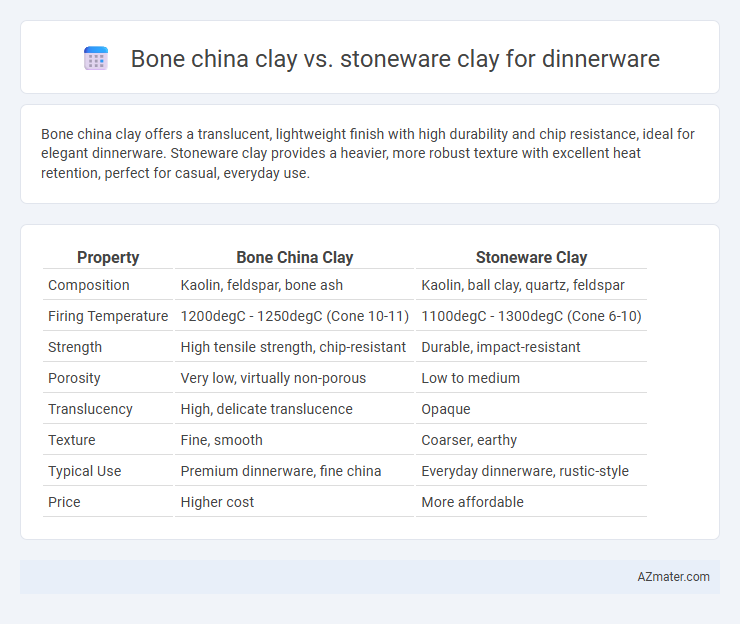Bone china clay offers a translucent, lightweight finish with high durability and chip resistance, ideal for elegant dinnerware. Stoneware clay provides a heavier, more robust texture with excellent heat retention, perfect for casual, everyday use.
Table of Comparison
| Property | Bone China Clay | Stoneware Clay |
|---|---|---|
| Composition | Kaolin, feldspar, bone ash | Kaolin, ball clay, quartz, feldspar |
| Firing Temperature | 1200degC - 1250degC (Cone 10-11) | 1100degC - 1300degC (Cone 6-10) |
| Strength | High tensile strength, chip-resistant | Durable, impact-resistant |
| Porosity | Very low, virtually non-porous | Low to medium |
| Translucency | High, delicate translucence | Opaque |
| Texture | Fine, smooth | Coarser, earthy |
| Typical Use | Premium dinnerware, fine china | Everyday dinnerware, rustic-style |
| Price | Higher cost | More affordable |
Introduction to Bone China and Stoneware Clays
Bone china clay, composed of bone ash, kaolin, and feldspar, is renowned for its high translucency, whiteness, and strength, making it ideal for delicate yet durable dinnerware. Stoneware clay, a dense and non-porous material fired at high temperatures, offers robust durability and a rustic aesthetic favored for everyday use. Both clays differ significantly in composition and firing techniques, influencing their texture, strength, and thermal resistance in dinnerware production.
Composition and Raw Materials
Bone china clay is composed primarily of bone ash, kaolin, and feldspar, resulting in a highly refined, translucent, and lightweight material ideal for elegant dinnerware. Stoneware clay consists mainly of natural clay combined with various minerals such as quartz and feldspar, producing a dense, durable, and opaque ceramic well-suited for everyday use. The high bone ash content in bone china contributes to its strength and whiteness, while stoneware's natural clay mix provides robustness and chip resistance.
Manufacturing Processes Compared
Bone china clay undergoes a refined manufacturing process involving the incorporation of bone ash, kaolin, and feldspar, which are subjected to high-temperature firing around 1200-1250degC to achieve translucency and strength. Stoneware clay, made primarily of natural clay and feldspar, is fired at higher temperatures between 1200-1300degC, resulting in a dense, durable, and non-porous material without translucency. The manufacturing of bone china requires precise control of raw material proportions and firing conditions to balance whiteness and translucency, while stoneware production emphasizes robustness and thermal resistance through vitrification during firing.
Durability and Strength Differences
Bone china clay offers superior strength and durability due to its high porcelain content combined with bone ash, making it highly resistant to chipping and cracking compared to stoneware clay. Stoneware clay, while also robust and suitable for everyday use, is denser and less translucent but can be more prone to surface scratches and chip damage over time. The vitrification process in stoneware provides excellent resistance to moisture, but bone china's composition results in a lighter, yet stronger dinnerware ideal for fine dining settings.
Color and Aesthetic Appeal
Bone china clay offers a translucent, smooth surface with a delicate white color that enhances the brightness and elegance of dinnerware, making it highly prized for its refined aesthetic appeal. Stoneware clay features a more opaque and matte finish with earthy tones, providing a rustic and robust visual texture that complements casual and contemporary table settings. The choice between bone china and stoneware significantly influences the color vibrancy and overall visual impact of dinnerware collections.
Weight and Feel in Everyday Use
Bone china clay produces dinnerware that is notably lighter and more delicate-feeling than stoneware, offering a refined touch that enhances everyday dining experiences. Stoneware clay results in heavier, sturdier pieces that provide a substantial, durable feel, ideal for casual or frequent use. Choosing between bone china and stoneware depends on whether a lightweight elegance or robust practicality better suits daily meal service.
Heat and Chip Resistance
Bone china clay offers superior heat resistance and maintains structural integrity under high temperatures, making it highly suitable for dinnerware used in ovens and microwaves. Stoneware clay is also heat resistant but tends to be thicker and denser, which provides excellent chip resistance and durability for everyday use. While bone china is prized for its delicate translucency and refined finish, stoneware excels in toughness and resilience against chipping and thermal shocks.
Porosity and Food Safety
Bone china clay exhibits low porosity, making it highly non-absorbent and thus ideal for food safety since it prevents moisture and bacteria penetration. Stoneware clay has higher porosity, which often requires glazing to create a non-porous and food-safe surface, as unglazed stoneware can absorb liquids and harbor bacteria. Consequently, bone china is preferred for hygienic dinnerware with superior resistance to staining and odors.
Price and Market Availability
Bone china clay is generally more expensive than stoneware clay due to its refined materials, including bone ash, and labor-intensive manufacturing processes, resulting in higher-priced dinnerware. Stoneware clay offers a more affordable option with widespread market availability, making it popular for everyday dinnerware. Bone china is often found in premium and luxury segments, while stoneware dominates mass-market retail stores.
Choosing the Right Clay for Your Dinnerware
Bone china clay offers a translucent, delicate finish with high whiteness and durability, ideal for elegant, lightweight dinnerware. Stoneware clay provides a robust, opaque finish with superior chip resistance and earthy tones, perfect for everyday use with a rustic aesthetic. Choosing the right clay depends on balancing sophistication and strength to match your dinnerware's style and functional needs.

Infographic: Bone china clay vs Stoneware clay for Dinnerware
 azmater.com
azmater.com